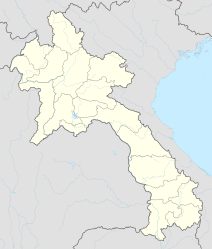Vieng Xai
|
ວຽງ ໄຊ Vieng Xai |
||
|---|---|---|
|
|
||
| Coordinates | 20 ° 24 ' N , 104 ° 14' E | |
| Basic data | ||
| Country | Laos | |
| Houaphan | ||
| ISO 3166-2 | LA-HO | |
| Residents | 32,800 (2000) | |
|
Main street of Vieng Xai
|
||
Vieng Xai ( Lao : ວຽງ ໄຊ or ເມືອງ ວຽງ ໄຊ , ALA-LC : vīang sai or mư̄ang vīang sai , pronounced [ʋíːə̯ŋ sáj] , also written Viengxay , Vieng Xay , Viang Xai , Viengsay , Vieng Say or Vieng Sai ) is a city in the Province Houaphan , east of Laos . The city has 32,800 inhabitants (as of 2000) .
geography
Vieng Xai is located 29 kilometers east of the provincial capital Sam Neua on National Road 6 and 55 kilometers from the nearest border crossing to Vietnam. The city lies in a valley, surrounded by mountains and cave-interspersed limestone cliffs.
History / caves
During the period of the Indochina War , from 1964 to 1973, the procommunist liberation movement Pathet Lao set up its headquarters in Vieng Xai and the leadership used several caves as apartments and shelters. There are 102 known caves in and around Vieng Xai, twelve of which were used during the war. The caves were almost invulnerable from the air and therefore offered safe protection.
The Prince Souphanouvong , the later Presidents Nouhak Phoumsavanh and Khamtay Siphandone and the later Prime Minister and President Kaysone Phomvihane lived here . However, they were not purely residential. In addition to bedrooms, the caves used also had libraries, conference rooms, armories, a room for the party leadership and more. Other caves served as a hospital, weaving mill, printing works, schools and a theater. The party leadership was thus independent of external supplies. About 20,000 people lived for years in the cave complex which was almost continuously the target of B-52 bombers of the American Air Force . Only at night could the farmers work their rice fields and graze their buffalo. The area is considered to be one of the most heavily bombed areas on earth and even today duds pose a great danger that cost hundreds of lives every year.
The government kept the caves closed until the mid-1990s. Today, a dozen of them are open to the public and represent the city's greatest tourist attraction.
gallery
Web links
Web pages
- www.telegraph.co.uk Viengxay caves, Laos: where Thousands hid from American bombs (English)
- www.mekongresponsibletourism.org Explore Viengxay cave complex, the birthplace of Lao PDR English
Individual evidence
- ↑ Laos - Pathet Lao Caves, Viengxay, Houaphanh province From the caves at Viengxay, between 1964 and 1973 the Pathet Laos politburo ran its government and military affairs. At the time, this cave complex was the nerve center of the communist insurgency against the US backed Royal Lao Government. At its height, around 20,000 Pathet Lao government officials, various government departments and wider supporters lived and worked in these caves. 18 of them are now open to the public in an extremely scenic area spread out over several kilometers.
- ↑ www.mekongresponsibletourism.org The war is still having its effect on children born decades after the conflict ended. UXO - explosive ordnance that didn't detonate when fired or dropped - contaminates the whole country and prevents people from using land. UXO might be hidden under a school playing field or a house, or in fields…. When they are disturbed, by digging or often by children picking them up and playing with them, they explode. It is estimated that UXO kills and injures one person a day, every day in Laos and that it will take another 20 years to clear them.





